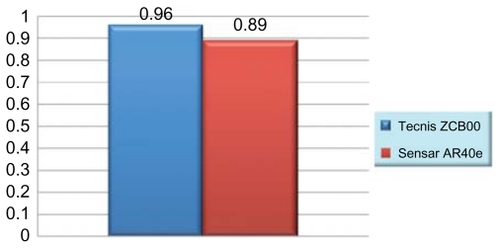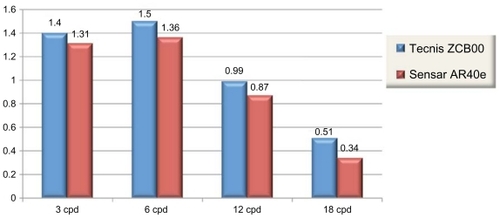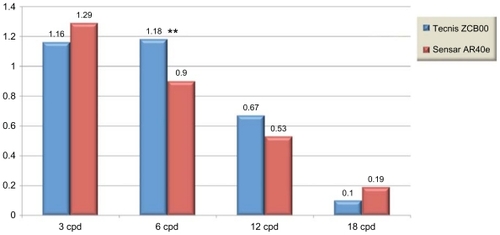Abstract
Synopsis
The aspheric, one-piece design of the Tecnis® ZCB00 intraocular lens provided higher mesopic contrast sensitivity and relatively constant refraction at different pupil sizes compared to the Sensar® AR40e.
Purpose
Comparing the impact on functional vision of the aspheric Tecnis® ZCB00 one-piece lens compared to the spherical Sensar® AR40e three-piece lens.
Setting
National Eye Hospital, Cairo, Egypt.
Methods
In this prospective study, we implanted 32 Tecnis ZCB00 (Abbott Medical Optics, Santa Ana, CA) and 30 Sensar AR40e (Pharamacia and Upjohn LLC, North Peapack, NJ) lenses. Twenty-three patients in the ZCB00 group and 13 patients in the AR40e group provided reliable, reproducible data, and were therefore included in the statistical analysis. After 8 weeks, we measured photopic contrast sensitivity (PCS) at 85 cd/m2 and mesopic contrast sensitivity (MCS) at 5 cd/m2. Uncorrected and best-corrected visual acuity were measured. Myopic shift was analyzed by comparing the manifest refraction spherical equivalent at 3 days and 8 weeks after surgery in the normal and dilated pupil.
Results
The Tecnis ZCB00 group showed significantly better MCS than the Sensar AR40e group at a spatial frequency of six cycles per degree (cpd) (P = 0.037), but not at 3, 12, or 18 cpd (P = 0.299, P = 0.226, and P = 0.396, respectively). There were no significant differences between groups in corrected distance visual acuity (P = 0.175) or PCS at 3, 6, 12, or 18 cpd spatial frequencies (P = 0.440, P = 0.176, P = 0.365, and P = 0.251, respectively). The ZCB00 group showed less myopic shift in normal and dilated pupils between 3 days and 8 weeks after surgery compared to the AR40e group, but this difference was not significant.
Conclusion
The Tecnis one-piece ZCB00 provided higher MCS at moderate spatial frequency than the three-piece Sensar AR40e, and was associated with relatively constant refraction at different pupil sizes.
Introduction
The decreases in visual acuity and contrast sensitivity that occur with age are usually attributed to changes in the lens.Citation1 The crystalline lens undergoes positive spherical aberration (SA) with age, which disrupts the wave front balance with the cornea and increases the positive SA of the whole eye.Citation2 In young subjects, the crystalline lens compensates for any positive SA in the cornea with negative SA, which results in a low level of SA for the entire eye.Citation3 Traditional intraocular lenses (IOLs) also have positive SA, and therefore, they produce a pseudophakic eye that is no better than an aged eye with a transparent lens in this regard.Citation4
Aspheric IOLs are designed to introduce optical path differences that bend the light rays to a single focus on the retina. There are several IOL designs that compensate for the SA by making one or both surfaces aspheric.Citation5
Several studiesCitation6–Citation10 have suggested that implantation of these aspheric IOLs might improve contrast sensitivity and enhance patient quality of life. However, othersCitation11 found no significant differences in contrast sensitivity between aspheric and spherical IOLs.
In this study, we compared the performance of the Tecnis® ZCB00 (Abbott Medical Optics, Santa Ana, CA) and Sensar® AR40e (Pharamacia and Upjohn LLC, North Peapack, NJ) with regard to their contribution to visual outcome and contrast sensitivity. Tecnis ZCB00 is a one-piece 6.0 mm biconvex hydrophobic acrylic lens with anterior aspheric surface that resulted in a negative SA of −0.27 μm and frosted continuous 360° posterior square edge. Sensar AR40e is a three-piece 6 mm biconvex spheric hydrophobic acrylic lens with OptiEdge™ (Abbott Medical Optics) design and polymethylmethacrylate (PMMA) haptic with 5° angulation ().
Table 1 Features of the two IOL types used in this study
Patients and methods
A randomized prospective study was conducted in 62 eyes in patients that required cataract surgery at the National Eye Hospital. Exclusion criteria included ocular surface pathology, uncontrolled glaucoma, existing retinal or optic disc pathology, and systemic diseases that could potentially affect the vision, like diabetes. After cataract removal, the patients were divided into two groups. The first group of 32 eyes received implants of aspheric Tecnis ZCB00 lenses (Abbott Medical Optics) and the second group of 30 eyes received implants of spherical Sensar AR40e lenses (Abbott Medical Optics). Informed consent was obtained from all participants and the study was reviewed by the National Eye Hospital ethics committee.
Surgical procedure
All surgical procedures were performed with the same technique, and the same phaco machine. After administration of periocular anesthesia, a corneal incision of 2.4 mm was performed in the steep meridian when possible, a 5-mm continuous capsulorhexis was performed, followed by phacoemulsification cataract extraction. Next, an IOL was implanted with an injector; then, the IOL was centered and the meticulous ophthalmic viscoelastic device was washed.
Evaluation
All patients had a full preoperative ocular examination, including refraction testing, best corrected distance visual acuity (CDVA) testing, tonometry, funduscopy, slit-lamp examination, and corneal topography. Patients were examined directly after surgery for the baseline data; then, again, at 2–3 days, 2 weeks, and 6–8 weeks after surgery. The data presented included refraction, CDVA (recorded in logarithm of minimum angle of resolution [logMAR]), corneal topography, photopic contrast sensitivity (PCS), and mesopic contrast sensitivity (MCS).
Contrast sensitivity was measured with the CSV1000E test (Good-Lite, Elgin, IL), using sine-wave grating charts to measure spatial frequencies of 3, 6, 12, and 18 cycles per degree (cpd). The CSV1000E test has been used in several studies and has been shown to give reliable, repeatable contrast sensitivity function scores.Citation12 All measurements were performed under photopic conditions at 85 cd/m2 and under mesopic conditions at 5 cd/m2.
According to Wachler and KruegerCitation13 contrast sensitivity values were normalized using the ratio between a patient’s result and the normal score for the patient’s age group. Scores higher or lower than 1.0 indicated contrast sensitivities higher or lower than expected.
Corneal topography was measured with a WaveLight® Allegro Oculyzer with software version 1.16r12 (WAVELIGHT AG, Erlangen, Germany) to ensure corneal regularity.
Statistical analysis
Data were collected, verified, and the changes were calculated with Microsoft Excel 2007. Statistical analyses were performed with MedCalc (v 11.1.1.0, MedCalc Software, Mariakerke, Belgium). The following tests were performed: calculation of the mean, standard deviation (SD), the t-test for independent samples of parametric data with equal variances, and the Welch test for independent samples of parametric data with unequal variances.
Results
Twenty-three patients in the Tecnis ZCB00 group and 13 patients in the SensarAR40e group attended all the follow-up visits in the study. Their data were reliable and reproducible (no same visit variability); therefore, all were included in the statistical analysis.
Patients
The mean age of the patients was 63.8 ± 10.4 years. The male to female ratio was 23:39. The right to left ratio was 20:16. The demographic characteristics of the study groups are reported in . The mean IOL power was 19.3 ± 5.3 in the Tecnis ZCB00 group, and 17.3 ± 6.3 in the Sensar AR40e group (P = 0.194) ().
Table 2 Study group demographics and IOL information
Table 3 Myopic shifts at different pupil sizes and mean IOL powers in the two study groups
Visual acuity
Two months post-operatively, the mean CDVA was 0.89 ± 0.17 in the Tecnis ZCB00 group, and 0.96 ± 0.14 in the Sensar AR40e group, with no significant difference between groups (P = 0.175) ().
Contrast sensitivity
The Tecnis ZCB00 one-piece showed better PCS than the Sensar AR40e three-piece at all spatial frequencies (, ), but there were no statistically significant differences between groups (P = 0.440, P = 0.176, P = 0.365, and P = 0.251, respectively).
Table 4 Mean photopic contrast sensitivities of the two study groups
At a spatial frequency of 6 cpd, the MCS was significantly better in the Tecnis ZCB00 one-piece group than in the SensarAR40e three-piece group (P = 0.037; , ); however, at spatial frequencies of 3, 12, or 18 cpd, the MCS was not significantly different between the two groups (P = 0.299, P = 0.226, and P = 0.396, respectively).
Table 5 Mean mesopic contrast sensitivities of the two study groups
Myopic shift
In undilated eyes, the change in spherical equivalent from 3 days to 2 months was lower in the Tecnis ZCB00 lenses (−0.06 D) than in Sensar AR40e lenses (−0.32 D), but this difference was not statistically significant (P = 0.194; ). In dilated eyes, the change in spherical equivalent from 3 days to 2 months was lower in the Tecnis ZCB00 lenses (0.06 D) than in the Sensar AR40e lenses (−0.16 D), but this difference was not statistically significant (P = 0.196; ). This indicated that there was less myopic shift with the Tecnis ZCB00 one-piece lenses than with the Sensar AR40e three-piece lenses in both dilated and undilated eyes.
Discussion
Optical aberrations during cataract surgery can be reduced by implanting aspheric IOL. Standard IOLs add positive SA to that already induced by the cornea and, thereby, they decrease optical quality. The goal of the current study was to evaluate the visual performance of aspheric Tecnis ZCB00 one-piece hydrophobic acrylic lenses and compare them to spherical Sensar AR40e three-piece hydrophobic acrylic lenses.
In this study, we found no significant difference between groups in the post-operative CDVA (P = 0.175). In contrast, Bellucci et alCitation10 compared the CDVA (logMAR) in patients that received implants of Tecnis Z9000 or conventional AcrySof SA60AT IOL. They reported a difference of approximately three letters in favor of the Tecnis Z9000 IOL implants. On the other hand, Thiagarajan et alCitation14 found a statistically significant difference in CDVA but not clinically important (relative difference 1.5%), between Akreos Adapt Advanced Optics (AO) (Bausch and Lomb, Inc, Rochester, NY) aspheric intraocular lens (IOL) and the Sensar AR40e spherical acrylic IOL, in favor of the spherical IOL.
In a study by Munoz et alCitation2, there were no statistically significant differences in CDVA among patients that received implants of aspheric Tecnis Z9000 IOL, the AR40e IOL, or the Stabibag (Carl Zeiss Meditec, Inc, Dublin, CA) IOLs. Pandita et alCitation15 evaluated the CDVA in patients that had implants of AcrySof SA60AT, AcrySof Natural SN60AT, or AcrySof IQ SN60WF IOLs; the results were similar among the three groups. Also, Morales et alCitation16 compared visual acuity in patients who had a spherical IOL (SoFlex SE, Bausch and Lomb) implanted in one eye and an aspheric IOL (SofPort AO, Bausch and Lomb) implanted in the fellow eye and there were no statistical differences among the two groups. Thus, the previous studies showed results similar to our results for the CDVA.
In the current study, we found no significant differences in the PCS between the Tecnis ZCB00 Aspheric IOL and the Sensar AR40e spherical IOL at all spatial frequencies. However, at 6 cpd, the MCS in the Tecnis ZCB00 was significantly better than that in the Sensar AR40e. Our results were comparable to those from the study by Denoyer et alCitation17 who compared aspheric Tecnis Z9000 and spherical CeeOn™ Edge 911 (Pharmacia, Kalamazoo, MI) IOLs. That study revealed that the Tecnis Z9000 group showed significantly better MCS at high spatial frequencies; however, the contrast sensitivity under photopic and glare conditions did not differ between the two groups. Also, the study by Morales et alCitation16 was comparable to our results; their study compared aspheric SofPort AO® IOL (Bausch and Lomb) and spherical SoFlex SE® IOL (Bausch and Lomb). They found no statistical difference between groups under photopic conditions but better performance was observed with the aspheric IOL at low spatial frequencies under mesopic conditions.
Ohtani et alCitation18 found no significant differences in contrast sensitivity, under either photopic or mesopic conditions, between patients that received implants of Tecnis Z9003 IOLs or the AR40e. Munoz et alCitation2 found that both the PCS and MCS were similar in patients that received implants of Tecnis Z9000, Sensar AR40e, or Stabibag IOLs. Also, Thiagarajan et alCitation14 found no statistically significant differences in contrast sensitivity between Akreos Adapt Advanced Optics aspheric intraocular lens (IOL) and the Sensar AR40e spherical acrylic IOL.
However, our results contrasted with those of Pandita et al.Citation15 They found that, compared to the AcrySof SA60AT and AcrySof SN60AT, the AcrySof IQ IOLs provided significantly higher PCS at 18 cpd, higher MCS with a 4.0 mm aperture at all spatial frequencies without glare and with glare, and higher MCS with a 6.0 mm aperture at all spatial frequencies without glare and with glare. Also, Bellucci et alCitation10 showed that, compared to AcrySof SA60AT IOLs, the Tecnis Z9000 IOLs provided better contrast sensitivity at 3, 6, 12, and 18 cpd in both photopic and mesopic conditions, with a peak improvement at 18 cpd.
There are several possible explanations for the lack of significant differences in visual performance among different IOLs. First, both IOLs used in our study were made of the same hydrophobic acrylic material. Second, the aspheric nature of the Tecnis one-piece ZCB00 will improve the SA of the eye, but this effect will mainly appear in mesopic conditions, as was the case in our study. Third, an improvement in the optical quality of the eye may not necessarily lead to an improvement in the quality of vision.
In the current study, there was less myopic shift with the Tecnis ZCB00 than with the Sensar AR40e in different pupil sizes, but this difference was not statistically significant. Our results were comparable to those of Bellucci et alCitation19 who found that, in contrast to the myopic shift that tends to occur with the implantation of a spherical IOL, no shift occurred when they implanted the Tecnis one-piece IOL.
Nejima et alCitation20 found that, although the MA60AC three-piece IOL showed significant forward shift and myopic refractive changes after surgery, the SA60AT one-piece IOL displayed little axial movement and was associated with highly stable refraction after surgery. Szurman et alCitation21 evaluated the aspheric design of the Tecnis one-piece and how it correlated to patient benefits in 102 patients; they found no myopic shifts at larger diameters. Petermeier et alCitation22 evaluated the influence of the pupil size on clinical results and objective parameters of optical quality of the Tecnis one-piece (ZCB00) IOLs. His study included 51 eyes; they found the defocus curves with a 3-mm and a 5-mm pinhole were not statistically significantly different, which was comparable to our results. Taken together, these results suggested that the one-piece design conferred more stable refraction at different pupil sizes.
In conclusion, we found that the aspheric property of the Tecnis one-piece ZCB00 IOL provided higher MCS at moderate spatial frequency than the spherical three-piece Sensar AR40e. Furthermore, its one-piece property was associated with a relatively constant refraction at different pupil sizes. In the future, a meta-analysis might provide conclusive evidence that could confirm or negate the real benefit of one IOL model compared to the others.
Disclosure
Sherein S Wahba and Maged M Roshdy received travel support from Abbott Medical Optics, Inc, Santa Ana, CA. Riad F Riad, Fathy F Morkos and Abdallah K Hassouna received travel support and equipment from Abbott Medical Optics, Inc, Santa Ana, CA and Alcon Laboratories, Inc, CA. The authors have no other financial interest in the products mentioned in this paper. This paper was presented at the XXVIII Congress of the ESCRS, Paris, France, September 4–8, 2010.
References
- OwsleyCSekulerRSiemsenDContrast sensitivity throughout adulthoodVision Res19832376896996613011
- MuñozGAlbarrán-DiegoCMontés-MicoRRodríguez-GalieteroAAlióJLSpherical aberration and contrast sensitivity after cataract surgery with the Tecnis Z9000 intraocular lensJ Cataract Refract Surg20063281320132716863968
- ArtalPBerrioEGuiraoAPiersPContribution of the cornea and internal surfaces to the changes of ocular aberrations with ageJ Opt Soc Am A Opt Image Sci Vis200219113714311778716
- AtchisonDADesign of aspheric intraocular lensesOphthalmic Physiol Opt19911121371462062538
- FranchiniACompromise between spherical and chromatic aberration and depth of focus in aspheric intraocular lensesJ Cataract Refract Surg200733349750917321402
- PackerMFineIHHoffmanRSPiersPAProspective randomized trial of an anterior surface modified prolate intraocular lensJ Refract Surg200218669269612458862
- MesterUDillingerPAnteristNImpact of a modified optic design on visual function: clinical comparative studyJ Cataract Refract Surg200329465266012686231
- KershnerRMRetinal image contrast and functional visual performance with aspheric, silicone, and acrylic intraocular lenses. Prospective evaluationJ Cataract Refract Surg20032991684169414522286
- PackerMFineIHHoffmanRSPiersPAImproved functional vision with a modified prolate intraocular lensJ Cataract Refract Surg200430598699215130633
- BellucciRScialdoneABurattoLVisual acuity and contrast sensitivity comparison between Tecnis and AcrySof SA60AT intraocular lenses: A multicenter randomized studyJ Cataract Refract Surg2005314712717 Erratum in: J Cataract Refract Surg. 2005;31(10):185715899447
- KasperTBührenJKohnenTVisual performance of aspherical and spherical intraocular lenses: intraindividual comparison of visual acuity, contrast sensitivity, and higher-order aberrationsJ Cataract Refract Surg200632122022202917137978
- QuesnelNMLovasikJVFerremiCBoileauMIeraciCLaser in situ keratomileusis for myopia and the contrast sensitivity functionJ Cataract Refract Surg2004301209121815177594
- WachlerBSKruegerRRNormalized contrast sensitivity valuesJ Refract Surg19981444634669699172
- ThiagarajanMMcClenaghanRAndersonDFComparison of visual performance with an aspheric intraocular lens and a spherical intraocular lensJ Cataract Refract Surg201137111993200022018363
- PanditaDRajSMVasavadaVAVasavadaVAKaziNSVasavadaARContrast sensitivity and glare disability after implantation of AcrySof IQ Natural aspherical intraocular lens: prospective randomized masked clinical trialJ Cataract Refract Surg200733460361017397731
- MoralesELRochaKMChalitaMRNoséWAvilaMPComparison of optical aberrations and contrast sensitivity between aspheric and spherical intraocular lensesJ Refract Surg2011271072372821853963
- DenoyerALe LezMLMajzoubSPisellaPJQuality of vision after cataract surgery after Tecnis Z9000 intraocular lens implantation: effect of contrast sensitivity and wavefront aberration improvements on the quality of daily visionJ Cataract Refract Surg200733221021617276260
- OhtaniSMiyataKSamejimaTHonbouMOshikaTIntraindividual Comparison of Aspherical and Spherical Intraocular Lenses of Same Material and PlatformOphthalmology200911689690119410948
- BellucciRMorselliSPiersPComparison of wavefront aberrations and optical quality of eyes implanted with five different intraocular lensesJ Refract Surg200420429730615307390
- NejimaRMiyaiTKataokaYProspective intrapatient comparison of 6.0-millimeter optic single-piece and 3-piece hydrophobic acrylic foldable intraocular lensesOphthalmology2006113458559016581420
- SzurmanPPetermeierKAspheric IOLs benefit quality of vision. Clinical results after Tecnis 1-Piece IOL implantation are promisingCataract & Refractive Surgery Today Europe20091718
- PetermeierKFrankCGekelerFSpitzerMSMessiasASzurmanPInfluence of the pupil size on visual quality and spherical aberration after implantation of the Tecnis 1-piece intraocular lensBr J Ophthalmol2011951424520576769


